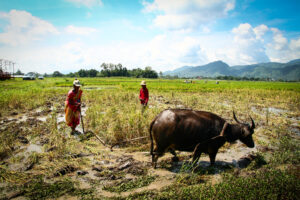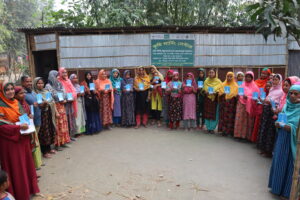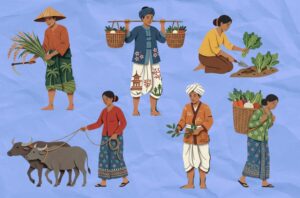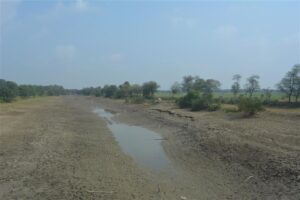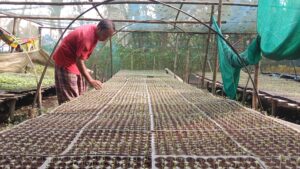by Muhammad Ashraful Habib, M. Mofijul Islam, Md. Ashraful Haque, et al.
The role of rice in global food security is unavoidable as it is one of the three most essential food crops globally, after wheat and maize. In Bangladesh, the area under rice cultivation, particularly boro rice, must be extended to meet the increasing food demand, which may cause significant CH4 emissions and ultimately accelerate the effects of global warming. Most previous studies have been conducted to quantify the effects of fertilizer and water regimes on GHG emissions from rice fields. However, the impacts of different rice cultivars under various water regimes on CH4 emissions, rice yields, and yield-contributing characteristics are poorly documented.
Rice is the staple food crop in Bangladesh and is cultivated in 11.4 million hectares (ha) across three crop-growing seasons per year. Of the three seasons, boro (dry season, December/January to March/April) results in an area under rice crop (irrigated rice) production of 4.8 million hectares.
The total rice production in Bangladesh was 36.6 million tons (t) in 2019/20, and Boro rice contributed the majority of the total production. Although rice plays a critical role in food security, it is associated with environmental pollution due to the emissions of greenhouse gases (GHGs), particularly methane (CH4).
Irrigated rice cultivation emits CH4, one of the main GHGs responsible for global warming and climate change. Lowland rice cultivation with continuous irrigation makes the soil environment anoxic, which favors the bacterial decomposition of organic materials through methanogenesis and produces CH4 gas. It is reported that rice cultivation accounts for 1.5% of all anthropogenic GHG emissions worldwide.
CH4 emissions are influenced by various soil; climatic; and crop management factors, including irrigation systems, crop variety, and fertilizer management. Continuous flooding (CF) irrigation, a common practice for lowland rice cultivation, produces a significant amount of CH4 and a limited amount of nitrous oxide (N2O).
CF irrigation lowers the redox potential (−150 mV), which enhances methanogenesis and results in the increased production of CH4. The CH4 produced in the soils is emitted to the atmosphere through three different pathways—ebullition, diffusion, and plant-mediated transport. The rice plant plays an important role, as more than 90% of CH4 is emitted from waterlogged soil to the atmosphere via aerenchyma cells.
In Bangladesh, boro rice cultivation consumes higher amounts of irrigation water, which is supplied through the extraction of groundwater. Because of continued extraction, the groundwater table has shown a declining trend and this has increased the irrigation costs for farmers. Therefore, the significance of water-saving irrigation methods, such as alternate wetting and drying (AWD), is increasing because they can reduce water use by up to 38% without reducing yield compared with farmers’ conventional irrigation method, i.e., CF.
Previous studies have reported that adopting AWD irrigation could reduce GHG emissions by up to 40% without any yield penalty. AWD irrigation reduces the total GHG emissions from rice fields, mostly because of decreased CH4 emissions, despite the fact that it may marginally increase N2O emissions. As a result, the most efficient strategy to reduce the global warming potential (GWP) of rice soil is to reduce the emission of CH4.
However, the impacts of AWD on rice yield are still contradictory and inconclusive. More studies are needed across different soil types and different agroecological zones, rice-growing seasons, and crop management practices, including different varieties, to develop a comprehensive picture of the effects of water-saving irrigation on rice yield and GHG emissions.
In addition to irrigation regimes, rice variety could affect emissions. Previous studies have shown a considerable difference in emissions among the different rice cultivars. The differences in emission rates are associated with the amount of root exudates, decaying of root tissues and leaf litter, accumulation of photosynthate in grain and straw, and crop growth duration.
There is also the potential option to reduce CH4 emissions through rice breeding, i.e., developing new varieties with a high-yielding capacity.
In Bangladesh, the area under rice cultivation, particularly boro rice, must be extended to meet the increasing food demand, which may cause significant CH4 emissions and ultimately accelerate the effects of global warming.
The role of rice in global food security is unavoidable as it is one of the three most essential food crops globally, after wheat and maize. Most previous studies have been conducted to quantify the effects of fertilizer and water regimes on GHG emissions from rice fields. However, the impacts of different rice cultivars under various water regimes on CH4 emissions, rice yields, and yield-contributing characteristics are poorly documented.
Therefore, the present investigation was conducted to determine the interaction effects of the rice variety and irrigation regime (AWD vs. CF) on rice yield and CH4 emissions during the boro season.
This study suggests that rice variety plays a vital role in mitigating CH4 emissions. However, there could be some yield penalty with this reduction.
The lowest CH4 emission was found in BINA dhan-17, but the rice yield was about 15% lower compared with BRRI dhan-69. These results indicate that the carbon credit calculation should also consider crop yield, as it is important for achieving food security, particularly in developing countries.
In this case, yield-scaled emissions are more important than area-scaled emissions. We suggest further studies be conducted in different agroclimatic zones of Bangladesh to confirm these findings.
Regardless of the varietal role, AWD irrigation has the potential to reduce cumulative CH4 emissions compared with CF irrigation, without any yield loss.
Therefore, climate-smart variety selection in combination with environmentally friendly irrigation management is effective at mitigating GHG emissions in lowland rice cultivation.
Read the study:
Habib MA, Islam SMM, Haque MA, Hassan L, Ali MZ, Nayak S, Dar MH, Gaihre YK. (2023) Effects of Irrigation Regimes and Rice Varieties on Methane Emissions and Yield of Dry Season Rice in Bangladesh. Soil Systems 7(2):41.

